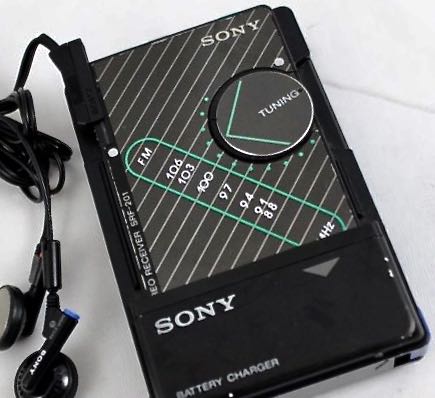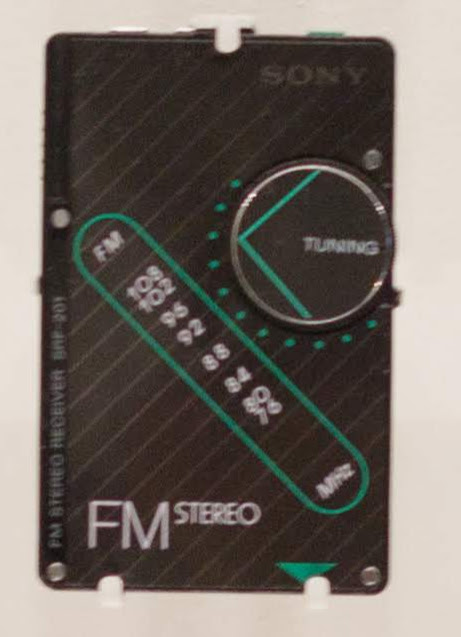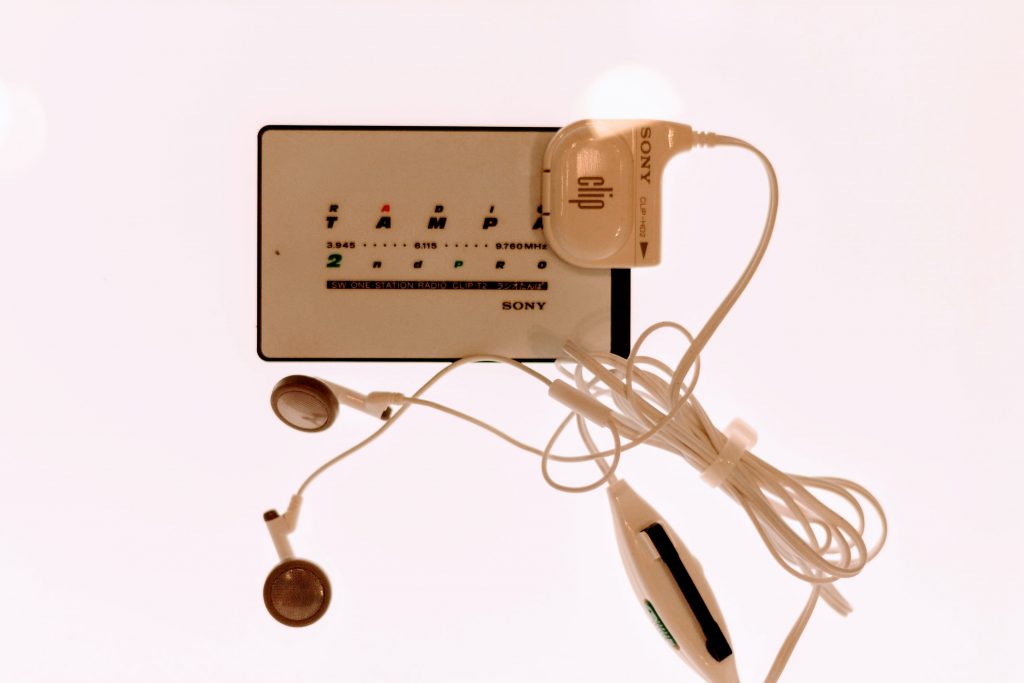Many thanks to SWLing Post contributor, Paul, who writes:
On a recent visit to London’s Design Museum, I was thrilled to see a number of very interesting radio designs and models, some of which were familiar, and others I had never seen before.
Two which caught my eye were tiny Sony models from the mid 1980s.
One – the Sony SRF 201 -seems to be a little more well-known, and I’ve found plenty of information about it online, including some for sale, although it seems that the internal battery in most models is shot.
The other, which I’ve not found much about yet, and am hoping you or your readers might help with, seems to be known as ‘SW One-Station Radio Clip T2‘. It looks as though it might be a branded/promotional model for Radio Tampa, and seems to be pre-set to, or allows tuning on, shortwave between 3.945/6.115/9.760 MHz. Possibly this one is more recent than the 1980s, looking at the earphones.
I’m having trouble finding much online about the second radio, and wondered if you could help shed some light on it? I can’t even find a ‘Radio Tampa’!
Unfortunately, while the museum has great iPads at each section with some more information, the unit at the Sony section was not functioning!
Post readers: If you can shed some more light on the SW One-Station Radio Clip T2, please comment!
Thanks for sharing this, Paul. I have a soft spot for credit card radios since I used to sneak one into my 5th grade class and listen to FM stations. Somehow, I never got caught!




I’m not sure if anyone monitors new replies to older posts, but this Twitter thread reminded me of these cute little Sony Clip radios, and sheds new light on their form factor, including that they had interchangeable ‘cards’! Really cool.
https://twitter.com/ticky/status/1247340722090422273
Commerical POP music stations (on shortwave) is I think a really interesting part of shortwave radio history. At the last SWL Winter Fest, I picked up a Sony radio guide (for Japanese teens) from these times. Sony was promoting shortwave radio listening to Japanese teens quite actively and many of the commercials on air were for Sony. Other advertisers included Coke etc.
As I wrote above the two main stations were Radio Tampa and KYOI Super Rock (pronounced KOI as in the Japanese Fish). Both were heard her in Australia easily each night and so I listen to them really frequently while studying etc.
Here are some recordings…
One clip of Radio Tampa:
http://www.intervalsignals.net/countries/japan.htm
Lots of clips of KYOI Super Rock
https://kyoi.zcm.com.au/kyoiaud.htm?
And these pages are both great reads:
https://kyoi.zcm.com.au
https://en.wikipedia.org/wiki/Superrock_KYOI
Brilliant stuff – thanks again Mark.
Yes, Radio Tampa = what is now known as Radio Nikkei. I’m sure I have a Radio Tampa QSL (from the 1980’s I guess it would be) when I get home from travels I will dig it out.
I listen to Radio Nikkei often, but when it was Radio Tampa it was slightly different – from memory the programming was Top 40 pop presented in a Japanese imitation of a USA commercial station format. Another great station back in those days was KYOI – Super Rock. Shortwave radio listening was a massive hobby for teenagers in Japan back then so the idea of Top 40 music on commercial radio shortwave stations made some sense. But that said neither station I think actually found the business model to be profitable.
Brilliant insight – many thanks. That sort of explains this ‘cool’ little gadget, then, and the branding.
Came across this blog by accident looking for something else. I lived in Japan from 1989-1992. I own both the Sony Clip-T1 and Clip-T2. These were only sold in Japan. The cards (Radio) were sold separately from the earphone battery assembly (sold separately). On the T1 and T2 there is a three position micro switch on the backside of the radio for each three frequencies. The Clip T1 is black in color with white lettering. The model# for the battery, volume and earphone assembly is Clip-HD2. All other Clip card radios on AM had frequencies in 9 kHz steps, unlike in the U.S. which has the AM band in 10 kHz steps. The exception was the FEN (Far East Network) card, which operated on 810 kHz, for the military audience in the Tokyo area. I have that card as well. The earphone, volume and battery assembly slides onto the side of the card, making contact with six micro terminals. I have used the T2 to obtain a QSL @ 6115 kHz from California.
More information on Radio Nikkei:
There are two programs of domestic shortwave broadcasting in Japan.
NSB or Nikkei 1 uses
3925 KHz (JOZ)
6055 KHz (JOZ2)
9525 KHz (JOZ3)
RN2 or Radio Nikkei 2 uses
3945 KHz (JOZ5)
6115 KHz (JOZ6)
9760 KHz (JOZ7)
The Sony ICF-EX5MKII radio receives all of these ( and no other shortwave frequencies.)
Apparently the SW One-Station Radio Clip T2 just receives Nikkei 2.
I wonder if there was a T1 for Nikkei 1?
That’s a really useful point – thanks so much for commenting. I wonder if there was a ‘T1’, too, or if the output of Radio Nikkei 2 (or Tampa, or whatever!) lent itself to doing a promotional pocket radio? (Maybe sports output, etc?)
Good catch! Any backstory on how these little receivers came to be? They must have been regional to Japan given the frequency span of the receivers. There has to be only a vanishingly few that exist in N. America. What a cool fnd!
There’s only ONE way to see if the battery can be replaced… 🙂
Not a SRF-201, but I owned a near-identical (Hanimex branded?) knockoff years ago – would’ve been the mid-late 80’s – that covered the full Australian / ITU region 1 band. So the style at least wasn’t restricted to Japan.
(It was probably tossed during a move – the battery was dead & I think leaking – but it may still be buried in one of my junkboxes somewhere…)
And … I just realised you were probably referring to the choice of SW band. Silly me 😉
Radio Tampa is the Japanese shortwave station known since 2003 as ‘Radio Nikkei’.
Aha! Fantastic, this is such useful information. Thanks!